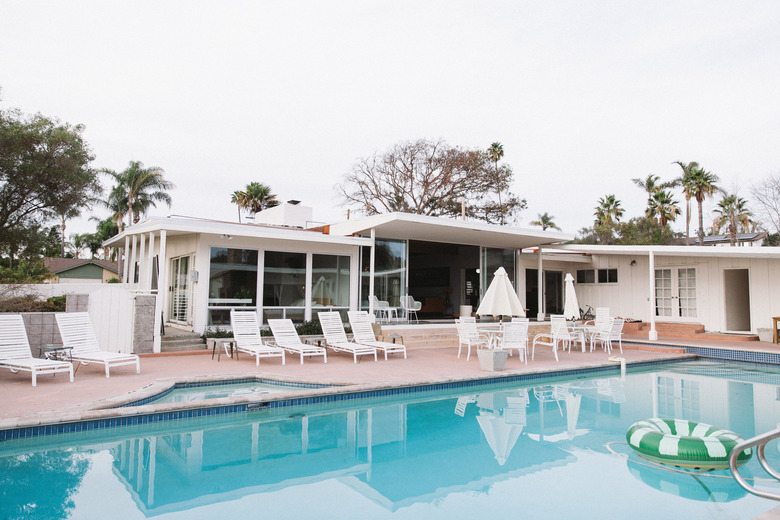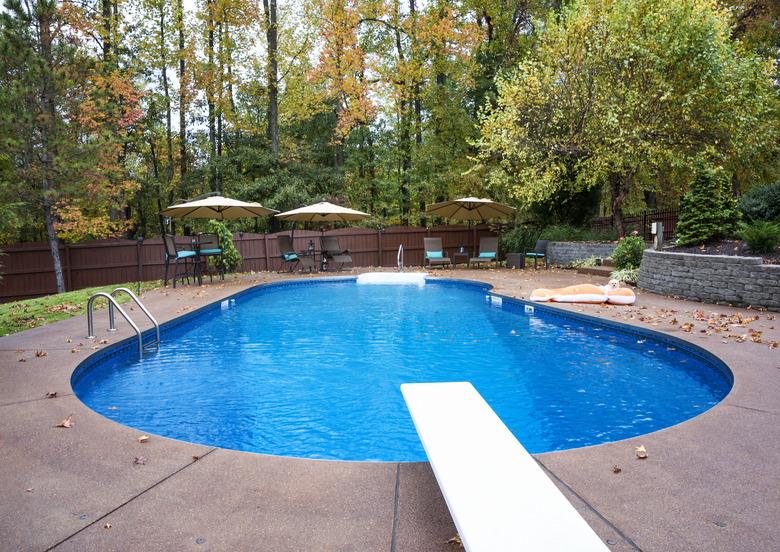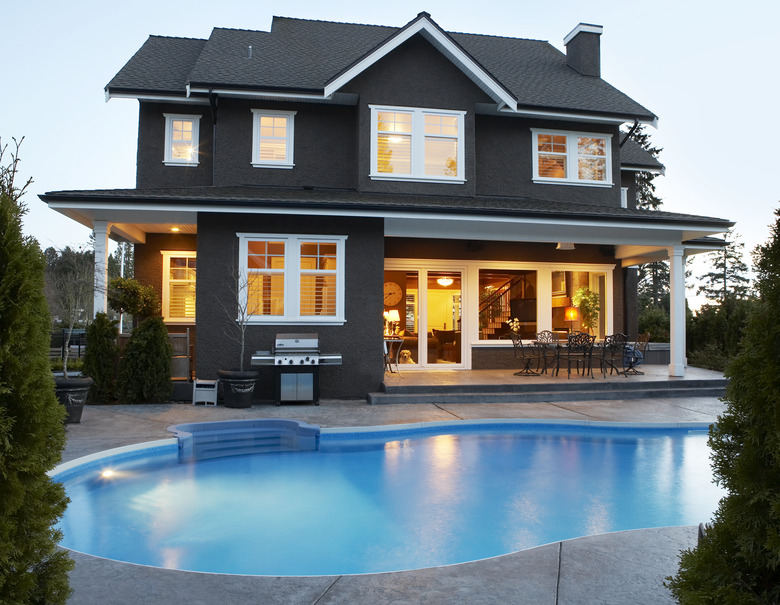Common Problems With In-Ground Swimming Pools
We may receive a commission on purchases made from links.
If you decide to install a swimming pool in your backyard, you don't need a crystal ball to predict that pool problems are probably in your future, particularly if you install an in-ground pool. However, there are millions of private pools and hundreds of thousands of public ones in the United States, which goes to show that pool problems can definitely be overcome and shouldn't prevent you from installing and enjoying one yourself. In fact, one of the most common problems — unhygienic water — is easily prevented with proper pool maintenance.
A number of structural and mechanical problems can beset in-ground pools and the equipment needed to circulate, filter and heat the water, and while many of these are preventable, some aren't and are inherent hazards of maintaining a large basin of water in a hole in the yard. Concrete and fiberglass pools can literally lift out of the ground if the water table is high enough, and a concrete pool can be subject to cracking, spalling and pool surface roughness, which is exacerbated by acidic or salty water.
An in-ground pool can leak, either through the plumbing or through a crack in the shell of the pool, and when that happens, it's a big headache. Fortunately, that doesn't happen very often, and if it does, it's usually easy to diagnose, although it might not be easy to fix. Catastrophes like this aside, you should be ready to handle a number of less serious but no less vexing pool problems that an owner of an in-ground swimming pool commonly confronts.
Algae Causes the Most Pool Problems
Algae Causes the Most Pool Problems
To the microscopic organisms known as algae, a hole in the ground full of water looks like home, and they will make it so if the water doesn't contain enough sanitizing agent to kill them. Algae buildup turns the water an uninviting green and sometimes brown color, and if you don't do anything, the colony grows, and the color deepens as the microbes gain a foothold on the bottom of the pool, on the sides and on ladders and other pool equipment.
When things reach this extreme, you have your work cut out for you because not only do you have to shock the water with high levels of chlorine and possibly an algicide but you usually also have to manually scrub the algae off any surface to which it is clinging. The job can easily consume the better part of a day.
To prevent algae growth, it's important to maintain chlorine levels in the range from 1 to 3 parts per million (ppm), and you should test daily using test strips and add more pool chlorine whenever the levels fall out of this range. The easiest way is to use chlorine tablets, which release chlorine slowly and often include a stabilizer to guard against ultraviolet deterioration. It isn't enough to just maintain chlorine levels, though, because chlorine won't work if the pool chemistry is off.
You must closely monitor pH — a measure of water acidity/alkalinity — and total alkalinity, which measures the concentration of alkaline material. Their levels determine the effectiveness of chlorine, and algae problems often occur when you fail to balance pH and alkalinity before testing for chlorine. The ideal pH is between 7.2 and 7.6, and the ideal alkalinity is between 80 and 120 ppm. You raise pH by adding baking soda or soda ash, and you lower it by adding muriatic acid or dry acid.
The Pool Water Can Turn Cloudy
The Pool Water Can Turn Cloudy
Pool owners often notice cloudy pool water in the spring after opening the pool or after a heavy rainstorm. This could indicate the beginning of an algae problem, but there are several other possibilities, including:
- The pH or total alkalinity is too high, which causes the formation of calcium deposits. The total calcium hardness, which you can check with a test kit, should be in a range from 200 to 400 ppm.
- The pool filter is dirty and needs to be cleaned, backwashed or replaced.
- An unusual amount of debris, such as leaves, dust and pollen, has fallen in the pool.
- The water has too much cyanuric acid, which is a chlorine stabilizer, and bacteria are converting it to ammonia.
- You just had a pool party, and the water is clouded by body oils, essential oils, sunscreen oil and possibly even motor oil if any of the partygoers are mechanics.
It isn't always easy to restore cloudy pool water to pristine clarity, especially if you have a saltwater pool that uses a chlorinator. The process may involve balancing chemicals, servicing the filtration system, using a pool clarifier or flocculant to settle particles out of the water so you can vacuum them from the bottom of the pool and even partially draining the pool and replacing the water.
An In-Ground Pool Costs a Lot to Heat
An In-Ground Pool Costs a Lot to Heat
If you have a heated pool, it takes fuel to run the heater and usually a lot of it. Multiply the dimensions of your pool, divide by 3 and multiply the result by 1,000 BTU to find the minimum heat output required to keep it warm. Using this formula, a 15 x 30-foot pool needs a minimum of 150,000 BTU, but more is better, so most pool installers would recommend upgrading to 200,000 BTU or more. Depending on the fuel your heater uses, you could pay $2.20 per hour for natural gas or $4.00 per hour for propane to supply that much heat. Electric heat pumps are the most economical depending on where you live but can still cost upward of $1.20 per hour.
These costs can add up quickly and can make heating your pool impractical depending on your budget. Thankfully, there's an easy DIY alternative to swimming in unheated water, and that alternative is to cover the pool with a solar insulating blanket. The blanket absorbs sunlight and transfers the heat into the water, and when the sun is down, the blanket prevents the heat from escaping. You may still have to run the pool heater but far less frequently than you would without a blanket, so this is one of the common pool problems that isn't difficult to solve, especially for an in-ground pool, which has the advantage of being insulated on all sides by the ground.
The Pool Pump Can Stop Working
The Pool Pump Can Stop Working
The pool pump is the heart of a swimming pool's circulation system, and when it doesn't work properly, it's almost impossible to balance the pool chemistry and keep the water clear. Sometimes, the pump loses its prime, which can happen if there's a small leak in the plumbing that allows air to replace water in the pump cavity. It's usually easy to re-prime the pump using the owner's manual as a guide, but before you do that, you have to find and fix the leak, which can be tricky and may require professional help.
The pump won't work properly if debris is clogging the intake port, which is usually a sign that you haven't been cleaning the skimmer and filter as often as you should. The danger with neglecting this routine maintenance task is that the pump is working harder and less efficiently, and it can burn out, especially if debris gets stuck inside the impeller and prevents it from spinning. If the pump makes a humming sound but doesn't actually turn on, that's probably what has happened, and you usually have to disassemble the pump to clean it.
Pools Can Leak and Lift
Pools Can Leak and Lift
If you don't keep your pool covered, you can expect the pool water level to decrease by 1 to 1 1/2 inches per week. If the waterline goes down more than this, it usually indicates a leak, and if you can't find anything wrong with the plumbing, the pool itself is leaking. This is not a good situation for an in-ground pool because the water could be undermining the soil underneath the pool, and the entire pool could sink. Leaks in concrete, gunite and fiberglass pools usually require professional repair.
Cracks are more common in a concrete or gunite pool than in a fiberglass pool, and to prevent them, you need to replaster the pool every 10 to 15 years, which can cost $12,000 to $20,000. Replastering is also necessary to repair spalling and roughness caused by acidic water, which can also discolor cementitious pool walls much more readily than fiberglass walls.
If the water table is high enough, hydrostatic pressure from the groundwater can lift an in-ground pool out of the ground, especially when the ground freezes over. This is a common problem with fence posts and foundation footings, which is why builders usually set them below the frost line. In a northern climate zone, it may be possible to dig the deep end of the pool below the frost line but not necessarily the shallow end, and even so, lifting can also happen when the ground is warm. The usual way to prevent lifting is to install and maintain a hydrostatic relief valve in the bottom of the pool.
The Pool Deck Can Chip or Crack
The Pool Deck Can Chip or Crack
A pool deck made of concrete or pavers, like a patio, is vulnerable to shifts in the soil caused by erosion, and when the deck cracks, it renders the area around the pool unsafe. The usual way to prevent this is to build the deck on a gravel base, but even that won't help if the pool is near a slope that directs water toward the deck. The solution might be to build a retaining wall or French drain system, which is a significant extra expense for which you might not have planned in your swimming pool budget.
A Swimming Pool Needs to Be Winterized
A Swimming Pool Needs to Be Winterized
If you live in a part of the country that gets freezing temperatures in winter, you have to winterize your pool before the cold weather sets in to protect the pump and other equipment. Although this could be considered routine maintenance, it's a fairly large job that you might not want to do yourself, and in that case, you have to figure the expense of hiring a pro to do it. The job usually entails disconnecting the power, filling the pool plumbing with antifreeze and strapping down a pool cover tightly enough to prevent it from blowing away during a winter storm.
The process of reopening the pool in the spring can be just as time-consuming and perhaps even more so. Besides flushing the antifreeze out of the system, cleaning the filters, re-priming the pump and refilling the pool to replace the water that evaporated over the winter, you also have to balance the pool chemistry and shock the water before the pool is ready for swimmers. While this might not be considered a pool "problem," it's definitely a consideration if you're planning a new pool.
References
- LiveAbout: Fascinating Facts About Pools, Spas, Swimming and Safety
- Swim University: How to Fix Cloudy Pool Water
- American Leak Detection: Top 10 In-Ground Swimming Pool Issues
- PoolSupplyWorld: What's the Cost to Run a Pool Heater?
- PoolSupplyWorld: 7 Common Pool Pump Issues and How To Fix Them
- River Pools: 10 Common Concrete Pool Problems and How to Avoid Them


